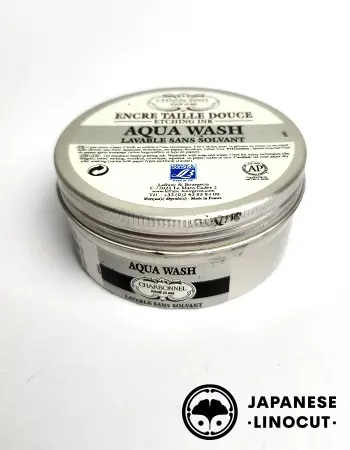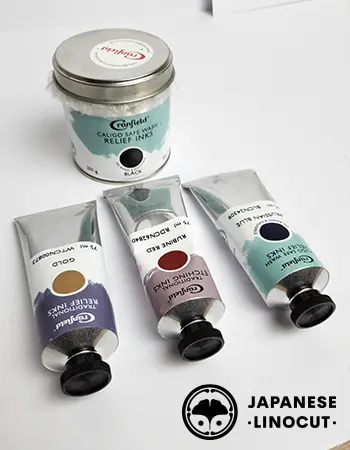Summary
ToggleInks for printmaking
There are many choices of inks for the realization of linocuts. Water-based inks, oil-based inks that can be cleaned with water, oil-based inks that are not water soluble, letterpress inks to name a few, are just a few examples. So how do you choose the right type of ink and the right manufacturer? We will address this issue in this article.
Water-based inks for linocutting
Water-based inks are at first sight a good choice when you want to learn about linocut. They are inexpensive, offer a variety of colors and are easy to clean. But in reality I don’t recommend these ranges especially if you are not equipped with a printing press.

I will not dwell on the inks that I do not recommend, but if I had to recommend only two to leave the choice I would say the Gerstaecker ink which works rather well and can give good renderings, as a test, as well as the college Linol range from Schmincke with which I was able to achieve perfect flat tints with deep blacks.
Note that among the advantages of these inks we can cite that they dry really fast. This will be useful for testing, for example. They are also easily found in graphic arts stores.
Note: Whatever ink I use, I don’t work it with a spatula but with a roller directly. I spread a line of ink with a knife the width of my Japanese brayer. And I just grazed this one with my roller. I will then do a lot of back and forth on a glass plate, adding more ink little by little. The result is always the same. An extremely thin film of ink on the roll that doesn’t block out even the finest details. This technique works perfectly whether the ink is viscous or liquid and always results in the same quality. The mistake not to make is to put too much ink on the roll at once. You should try to get a micro film of ink on your roller and ink your plate in several times at first.
Water-soluble oil-based inks for printmaking

They are much more qualitative than water-based inks and allow high quality prints. While their drying time may be one of their weaknesses, the advantages are far more numerous.
Oil-based linocut inks are already very pleasant to work with. They do not dry out during work or at least not as quickly as water-based products, which makes sense. They also spread very well with a brayer and adhere perfectly to linoleum.
I’ve said it before but I’ll say it again, oil-based linocut inks from Cranfield, for example, are excellent for quality lino prints whether you have a printing press or not. Be careful, however. I would like to point out that this will depend on the paper used as well. The smoother your paper, the more you can do without a press. Conversely, a heavily textured paper will give you more trouble to be fully inked. The weight of the paper is also important. The main thing is to test again and again. Don’t hesitate to find my advices to know which paper to use for printmaking.

To speed up the drying process you can use drier but I must admit I am not a fan of this solution. That’s why I have chosen to work exclusively with the Cranfield range of inks, which have all the advantages without the disadvantages for me. They are beautiful, work wonderfully well, don’t clog any details, are unparalleled in finesse and dry fairly quickly. The negative point will be on the supply side since to my knowledge no French store sells it. I buy my supplies from jacksonsart.com which is an excellent store to get quality material.
Letterpress oil inks for linocuts
Again I will not denigrate the inks that I personally do not like but I will encourage you to use the traditional relief inks from Cranfield. Not surprisingly, these oil inks are ideal for printmaking. At least if you are not afraid of cleaning. Indeed, if we can blame them for anything, it’s this. You will need to arm yourself with rags and vegetable oil. It is useless to force to obtain a good result. It will just take a little patience and several passes to restore your linoleum to its original appearance.
You can use chemical compounds such as white spirit for example, but this is not a panacea for the environment. I leave it to you to make your choice.
Coming back to our letterpress inks of the Cranfield range, you will obtain with, vibrant colors, well contrasted and very pleasant to work with. I encourage you to choose this range if your idea is to use gold, copper or silver colors. In my opinion, the quality of these inks is without equivalent on the market today.
How to choose the right ink for printmaking?
As we have seen, there are several types of inks for linocut. I also encourage you to use only quality inks for your prints. Nothing is more frustrating than getting a bad print just because of the ink. So if I had one piece of advice to give you it would be to go for water-based inks for quick and easy to clean tests, and then go for quality inks for the final lino prints.
Which ink to use for block printing on textile ?

If you have any questions or suggestions, feel free to post them in comments. I would be delighted to discuss with you and guide you in your choices!



